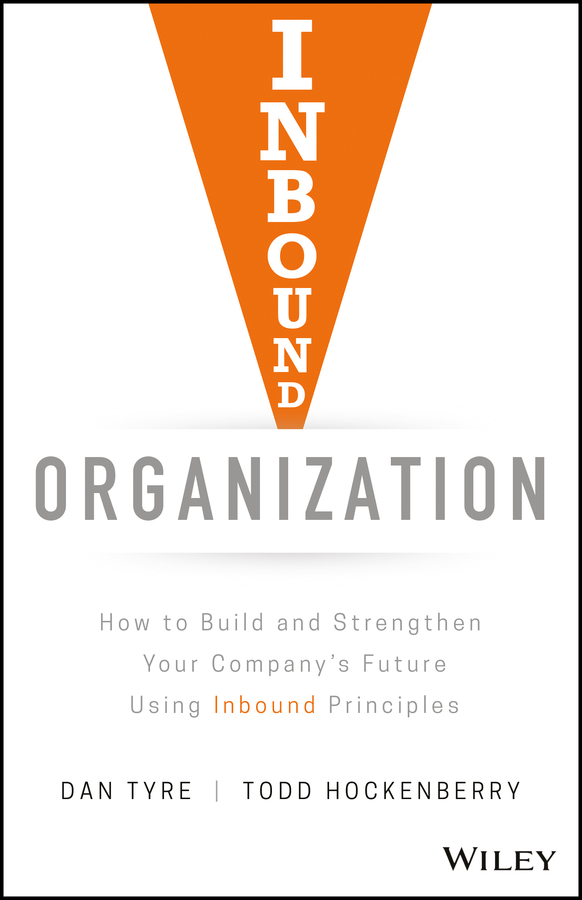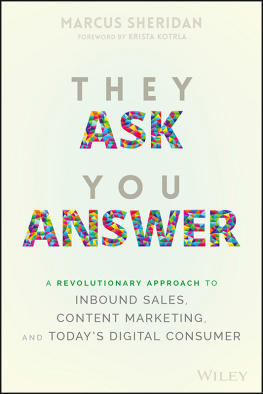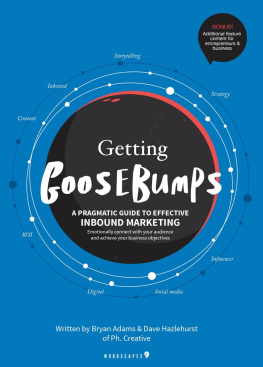
Cover design: Wiley
Author photos: Cy Cyr, Inc.
Copyright 2018 by John Wiley & Sons, Inc. All rights reserved.
Published by John Wiley & Sons, Inc., Hoboken, New Jersey.
Published simultaneously in Canada.
No part of this publication may be reproduced, stored in a retrieval system, or transmitted in any form or by any means, electronic, mechanical, photocopying, recording, scanning, or otherwise, except as permitted under Section 107 or 108 of the 1976 United States Copyright Act, without either the prior written permission of the Publisher, or authorization through payment of the appropriate per-copy fee to the Copyright Clearance Center, Inc., 222 Rosewood Drive, Danvers, MA 01923, (978) 7508400, fax (978) 6468600, or on the Web at www.copyright.com. Requests to the Publisher for permission should be addressed to the Permissions Department, John Wiley & Sons, Inc., 111 River Street, Hoboken, NJ 07030, (201) 7486011, fax (201) 7486008, or online at http://www.wiley.com/go/permissions.
Limit of Liability/Disclaimer of Warranty: While the publisher and author have used their best efforts in preparing this book, they make no representations or warranties with respect to the accuracy or completeness of the contents of this book and specifically disclaim any implied warranties of merchantability or fitness for a particular purpose. No warranty may be created or extended by sales representatives or written sales materials. The advice and strategies contained herein may not be suitable for your situation. You should consult with a professional where appropriate. Neither the publisher nor author shall be liable for any loss of profit or any other commercial damages, including but not limited to special, incidental, consequential, or other damages.
For general information on our other products and services or for technical support, please contact our Customer Care Department within the United States at (800) 7622974, outside the United States at (317) 5723993 or fax (317) 5724002.
Wiley publishes in a variety of print and electronic formats and by print-on-demand. Some material included with standard print versions of this book may not be included in e-books or in print-on-demand. If this book refers to media such as a CD or DVD that is not included in the version you purchased, you may download this material at http://booksupport.wiley.com. For more information about Wiley products, visit www.wiley.com.
ISBN 9781119482451 (Hardcover)
ISBN 9781119482482 (ePDF)
ISBN 9781119482475 (ePub)
To business owners working hard every day to build a solution, product, or service that buyers love
To people working in those businesses trying their best to help
To the inbound believers at HubSpot, their partners, and their customers and users
To our families, who allowed us to share this book with you
Foreword
If you ask people who know us where Dharmesh and I got the idea to start HubSpot, they'll probably tell you our starting point was the shifting balance of power between buyers and sellers.
They wouldn't be wrong. The vendor-client relationship has changed, and it has permanently altered how we do business. But the real story is much bigger than that.
We didn't start HubSpot because we thought only marketing was changing. We started HubSpot because we saw technology changing the world faster than ever before, and we wanted to democratize that change so small businesses could unlock their potential and grow.
The buyer-seller relationship is just one example of the dozens of ways technology impacts the way we do business. It all started when people began taking the Internet (and the free flow of information it enabled) seriously, around the early 1990s. The rise of the Internet empowered people to educate themselves, share insights, and share feedback, and ultimately it allowed us to demand more for ourselves.
If all of this sounds painfully obvious, that's just a testament to how thoroughly the Internet has changed our expectations of the people we do business with. But back in 1990, you might not have seen any of this coming.
Unless you're Rick Levine, Christopher Locke, Doc Searls, or David Weinberger. In 2000, they penned the ahead-of-its-time book The Cluetrain Manifesto: The End of Business as Usual, which accurately predicted the Internet's impact on organizations' interactions with their employees and marketplace.
I first read the manifesto when I was working for Ray Ozzie at Groove Networks, a legendary software entrepreneur who became CTO of Microsoft after they acquired Groove. He believed these four authors were seeing into the future, and he built Groove to help organizations run the way the Cluetrain Manifesto authors thought they should.
The authors had one message they wanted businesses to hear, loud and clear: We are not seats or eyeballs or end users or consumers. We are human beingsand our reach exceeds your grasp.
In other words, this is the core philosophy HubSpot was founded upon: treat everybody like they're a human or become obsolete. We call it inbound.
The book begins with 95 theses, a play on Martin Luther's 95 theses that he nailed to a church door in Germany. Most of these theses still ring true today and in many ways describe a world we still haven't reached. Here are some of my favorites:
- Markets are conversations.
- Markets consist of human beings, not demographic sectors.
- Conversations among human beings sound human. They are conducted in a human voice.
- Whether delivering information, opinions, perspectives, dissenting arguments, or humorous asides, the human voice is typically open, natural, and uncontrived.
- People recognize each other as such from the sound of this voice.
- The Internet is enabling conversations among human beings that were simply not possible in the era of mass media.
- In both internetworked markets and among intranetworked employees, people are speaking to each other in a powerful new way.
- These networked conversations are enabling powerful new forms of social organization and knowledge exchange to emerge.
- As a result, markets are getting smarter, more informed, more organized. Participation in a networked market changes people fundamentally.
When Dharmesh and I founded HubSpot, we baked these principles into the core of our product and go-to-market strategy. We wanted to disrupt the way companies engage with their markets, and we've always been committed to helping our prospects rather than treating them like lines on a P&L.
We didn't stop with the product, though. The Cluetrain Manifesto isn't just about companies and their marketsit touches every aspect of how organizations do business, externally and internally. Companies that can't recognize what their constituents want won't be able to compete and will go away.
Why?
First, the Internet drastically changed the power dynamic between companies and their employees.
In the pre-Internet age, career development went something like this: People would graduate high school or college, take a job, and work their way up the corporate ladder. Employees tended to stay with the same company for many years, and frontline workers didn't have much influence in decision making.
Most organizations were rigidly hierarchical and designed to keep leverage in the employer's hands. Companies placed their key decision makers at the top of a pyramid, and everyone below fed them information.
Before the Internet, this was the most efficient way for companies to operate. Individual frontline employees worked on tiny slices of the company, and they had little influence or knowledge that could contribute to major decisions.
Next page







